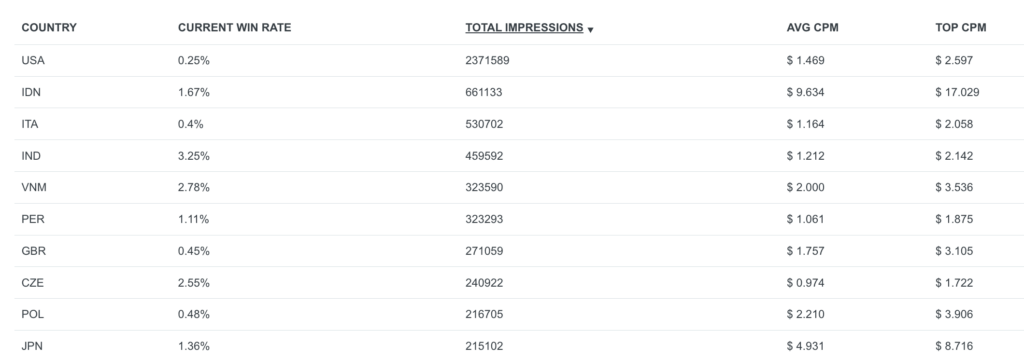Impressions
Impressions are a key term in digital marketing used to measure how many times your ad is displayed to users. Every time your ad appears on a user’s screen, it counts as one impression. This metric is key to measuring the reach of an ad campaign and how often your ads are being seen by potential customers. In this article, we’ll break down what impressions are, how they’re counted and how to use them for boosting your campaign. With ROIads ad network, you’ll master both the theoretical and technical aspects of successful affiliate marketing to maximize your understanding and results.
Impressions: What Is It?
Impressions are one of the core metrics in online advertising. In digital marketing, an impression is when an ad is shown to a user, whether it’s a banner, video, push notification or pop ad. An impression is counted when the ad is visible to the user, regardless of whether they interact with it.

In short, impressions definition refers to a measure of how many times an ad is seen. They track the total number of times an ad is shown across a network but don’t guarantee the user engaged with it. Impressions are one of the most basic and widely used metrics in online advertising especially in cost-per-thousand impressions (CPM) payment model.
Impressions: How They Work
There are different types of impressions depending on the ad format and how it’s delivered:
- Impressions for Display Ads
This type of impression is counted every time a banner or video ad is loaded on a page. For example a banner ad on a news website: every time the page with the ad is loaded it’s an impression.
- Impressions for Push Notifications
For push notifications, an impression is counted when the notification is delivered to the user’s device. Even if the notification is not opened or clicked it’s still considered as delivered so it’s an impression. This ad format is used to boost visibility by reaching users directly on their devices.
- Impressions for Pops
For pop ads also known as popunders an impression is logged when the ad opens in a new browser window. This type of ad is less visible because it appears behind the main content but it’s still an impression. Popunder ads can generate a lot of impressions but you should monitor how these impressions convert into actual user actions.
- Video Ad Impressions
For video ads like those on YouTube or other streaming services an impression is counted when the video starts playing on the user’s screen. Note that these impressions can be further broken down by duration of view as partial views can affect the ad’s performance metrics.
Why Impressions Matter in CPM Campaigns
In CPM (Cost-Per-Mille) advertising where you pay per 1000 impressions, impressions are the metric that drives the whole model. Unlike other advertising models like CPC (Cost-Per-Click) or CPA (Cost-Per-Action) where the focus is on user engagement or actions, CPM campaigns are all about how many times an ad is shown to users. So impressions are the most important metric for advertisers to monitor and optimize in CPM campaigns. Let’s dive into why impressions matter in CPM campaigns and how they impact their success.
Impressions — Meaning for Advertisers
Impressions are key in ad campaigns. They allow you to see how well your ads are being seen by an audience. But remember, impressions only measure visibility and don’t guarantee user engagement.
Why Impressions Are Important
- Audience Reach: Impressions show how many people your ad is being shown to and how many are seeing it. This is especially important in the early stages of a campaign when you want to reach as many users as possible.
- Visibility Check: Impressions let you see if your ad is being shown to your target audience even if they aren’t clicking on it. For example, a high number of impressions means your ad is well-placed and getting visibility.
- Compared to Other Metrics: Impressions are often compared to clicks (CTR) and conversions (CR). If you have a high number of impressions but few clicks or actions, your ad may not be resonating with your target audience or needs better targeting.
Impressions Example: How to Track and Analyze
For example, your ad was shown 100,000 times in a week. These 100,000 displays your impressions. To measure the campaign effectiveness you’ll need to compare this number with the number of clicks your ad received and how many users took a desired action (signed up or bought).
How to Optimize Impressions for Better Results
Having a high number of impressions doesn’t mean success. To get the best results you need to focus on the quality of these impressions and make sure you’re targeting your audience. Here are a few tips to optimize impressions:
- Targeting: Make sure your ads are shown to the right audience. Setting precise targeting parameters like geo, devices and browser language can help reduce unnecessary impressions and increase CTR.
- Monitoring and Analysis: Track and analyze the relationship between impressions, clicks and conversions. If you have many impressions but low CTR and CR, it’s time to re-evaluate your targeting or ad creatives.
- Quality Ad Platforms: Use trusted ad networks like ROIads to run pops and push ads. Our platform specializes in delivering high-quality traffic, especially for popunder ad formats, which operate on a CPM model. Reliable platforms reduce the risk of inflated impressions and improve overall campaign performance.
Below, you can find the top geos for pop ads, as well as the average and top CPM rates for these regions.

Conclusion
Impressions are a key metric to measure the reach and visibility of your campaigns. Depending on the ad format (banners, push notifications, pops, video ads, etc.) impressions are counted differently but the core value remains the same: they are the first step in the user’s journey with your ad. But impressions alone don’t guarantee engagement so they should always be looked at with other metrics like clicks and conversions.









